
Fall Garden Chores: Dig & Store
Autumn’s dazzling colour show is at its peak and we’re busy raking leaves and putting the garden to bed.
Remember to dig and store your tender summer bulbs.
With the first light frosts, yellowing and withering foliage is a sign that it’s time to lift corms, tubers, and rhizomes, or tender bulbs better known as begonias, callas, cannas, dahlias and gladiolus.
Start by cutting back the foliage 2-3” inches above ground. When you do, make it an opportunity to reflect on the beauty of your summer garden. Which flowers filled you with excitement? Which cuttings made the most spectacular bouquets? Is there something you want try next year? It’s a great time to make notes in a garden journal.
Dig a wide and deep hole underneath and around the bulb to avoid causing any injury underground. Carefully lift the bulb and gently free of it excess soil without damaging the roots. You can do this over a wheel barrow or bucket to conserve your soil and return it to the garden.
Autumn’s dazzling colour show is at its peak and we’re busy raking leaves and putting the garden to bed. If you’re following a to-do list, remember to dig and store tender summer bulbs. With the first light frosts, yellowing and withering foliage is a sign that it’s time to lift corms, tubers, and rhizomes, or tender bulbs better known as begonias, callas, cannas, dahlias and gladiolus.
Start by cutting back the foliage 2-3” inches above ground. When you do, make it an opportunity to reflect on the beauty of your summer garden. Which flowers filled you with excitement? Which cuttings made the most spectacular bouquets? Is there something you want try next year? It’s a great time to make notes in a garden journal.
Dig a wide and deep hole underneath and around the bulb to avoid causing any injury underground. Carefully lift the bulb and gently free of it excess soil without damaging the roots. You can do this over a wheel barrow or bucket to conserve your soil and return it to the garden.
Tie a label tag on the bulbs with the variety name and colour. Famously, I always think I’m going to remember a specific bulb based on its shape or the way the stem was cut. But come next spring I’ve long since forgotten, and it’s hard to tell which one is which. If you’re storing smaller sized bulbs, use lunch sized brown paper bags with ventilation holes to contain them. You can write on the bag with a sharpie marker.
Bulbs should be completely dry before storage. Space them out on a screen or tray so that there is good air circulation around them. A dark, dry shed or garage with temperatures of 16—20°C (60-70°F) and little exposure to sunlight is an ideal place to leave them for four to seven days. This important period is called curing, and it allows the outer skins of corms and rhizomes to toughen up and survive the winter.
Gladiolus: New corms will have formed above the last season’s corm. When the bulbs are dry gently twist off the old corm and toss it out. You might also see some small miniature corms at the base of the old corm. If you are keen, you can save “cormlets” and plant them in the spring to grow, though they won’t reach full size or flower for several years.
Store bulbs in single layers in open top cardboard boxes placing a page of newspaper in-between the layers. Breathable brown paper bags with ventilation holes, nylons or cloth bags also work well. Repurpose an empty onion sack. If you desire, you can add a handful of dry peat or vermiculite in each layer. Keep the boxes in a cool, dry spot such as an unheated basement with consistent temperatures around 10°C (50°F) and good air circulation.
Check on your bulbs periodically through winter. If there are bulbs showing signs of decay or mold, remove them. If bulbs appear shriveled or shrunken up, a light misting of water from a spray bottle will keep them from drying out too much. Keep in mind when storing tender summer bulbs that they are still living plants, and just in a dormant state, so they may need a little attention through the winter.


